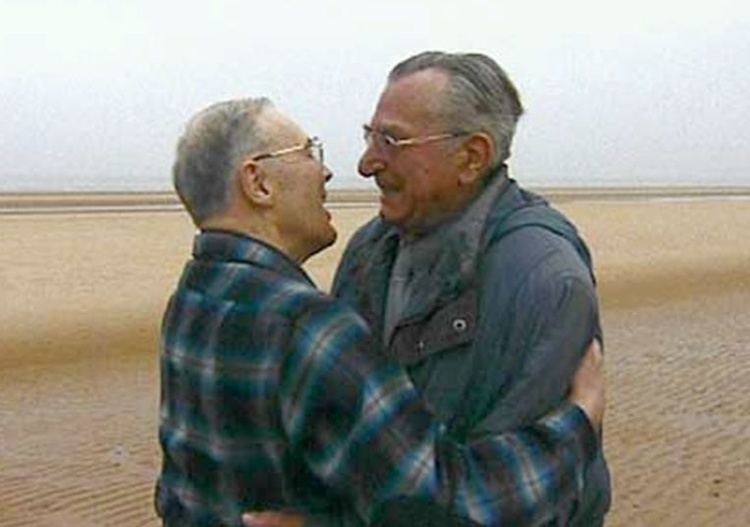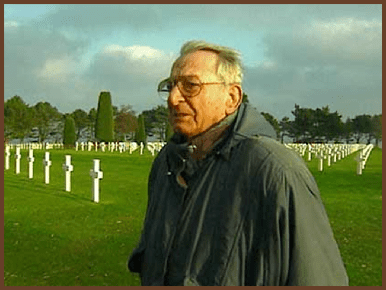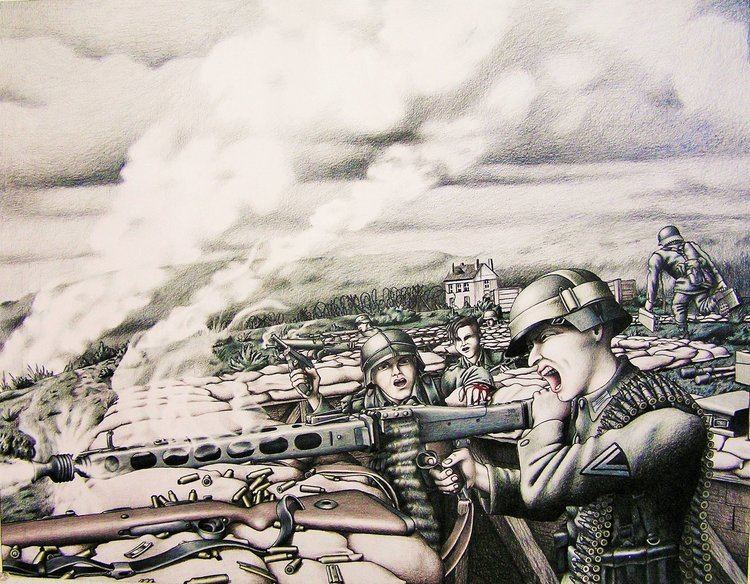Nickname(s) "The Beast of Omaha" Battles/wars World War IID-Day Name Heinrich Severloh | Role Author Years of service 1942–1944 Rank Corporal | |
 | ||
Battles and wars Normandy landings, World War II Born 23 June 1923 (age 82), Eldingen, Germany Died January 14, 2006 (aged 82), Lachendorf, Germany Similar Werner Pluskat , Simo Häyhä , Kurt Knispel | ||
Heinrich severloh die todfeinde von omaha beach
Heinrich Severloh (23 June 1923 – 14 January 2006) was a soldier in the German 352nd Infantry Division stationed in Normandy in 1944. He became infamous for a memoir WN 62 – Erinnerungen an Omaha Beach Normandie, 6. Juni 1944, published in 2000. This book is noted for the authors’ claim that as a machine gunner, Severloh inflicted over 2,000 casualties to American soldiers landing on Omaha Beach on D-Day, Subsequent to the book being published, some have referred to Severloh as “The Beast of Omaha.” However, Severloh’s claim is not viewed as credible by either US or German historians. Total US casualties (Killed, Wounded, Missing) from all sources at Omaha Beach on D-Day is estimated at 3,686.
Contents
- Heinrich severloh die todfeinde von omaha beach
- Heinrich Severloh
- Early life
- Service in the Wehrmacht
- Omaha Beach and Widerstandsnest 62
- Widerstandsnest 62
- Later life and death
- Historical view of the Sector
- Captivity
- Widerstandsnest 62 today
- David Silva
- References

Heinrich Severloh
Early life

Severloh was born into a farming family in Metzingen in the Lüneburg Heath area of North Germany, close to the small city of Celle.
Service in the Wehrmacht
Conscripted into the Wehrmacht on July 23, 1942, at the age of 19, Severloh was assigned to the 19th Light Artillery Replacement Division in Hanover. He was then transferred to France in August to join the 3rd Battery of the 321st Artillery Regiment, where he trained as a dispatch rider.

In December 1942, he was sent to the Eastern Front and assigned to the rear of his division to drive sleighs. As punishment for making dissenting remarks, he was forced to perform physical exertions which left him with permanent health problems and necessitated six-month convalescence in hospital. After this, he went on leave to his family's farm to help gather the harvest.
In October 1943, Severloh was sent for non-commissioned officer training in Brunswick, but was recalled after less than a month to rejoin his unit which had been reclassified as the 352nd Infantry Division and was stationed in Normandy.
Omaha Beach and Widerstandsnest 62
Omaha Beach extends for 5 miles (8 km) from east of Sainte-Honorine-des-Pertes to west of Vierville-sur-Mer. Post-war research of German military archives by the authors Randy Holderfield and Michael Varhola reveal that beach defences at Omaha consisted of 8 concrete bunkers containing 75 mm or greater artillery, 35 pillboxes, 18 anti-tank guns, six mortar pits, 35 Nebelwerfer (multi-barrel rocket launchers), 85 machine gun nests, 6 tank turrets and supporting infantry.
Infantry deployments on the Beach consisted of five companies concentrated at 15 strongpoints called Widerstandsnester (Resistance Nests), numbered WN-60 in the east to WN-74 in the west. Severloh was part of WN-62, the largest strongpoint defending Omaha Beach.
The American plan of attack divided Omaha Beach into ten sectors, codenamed Able, Baker, Charlie, Dog Green, Dog White, Dog Red, Easy Green, Easy Red, Fox Green and Fox Red. WN-62 at the eastern side of Omaha Beach overlooked both Easy Red and Fox Green sectors.
Widerstandsnest 62
WN-62 was 332 meters long by 324 meters wide and between 12 and 50 meters above the beach, depending on the distance from the shore, with a good overview of the beach area. The foxhole Severloh claimed to have fired from (49°21′36″N 0°50′50″W) was 170 meters from the sea wall and around 450 meters from the landing area of the first wave of Higgins Boats.
On D-Day (June 6, 1944) WN-62 was manned by 27 members of the 716th Infantry Division and 13 members of Severloh's 352nd Division, whose task was to direct fire of the 10.5 cm artillery batteries located 5 kilometres inland at Houtteville.
Defences included two type H669 concrete casemates, one empty and the other with a 75mm artillery piece, a 50mm anti-tank gun, two 50mm mortars, a twin-barrelled MG34 7.92mm machine gun on an anti-aircraft mount and two pre war Polish machine guns. Another 50 mm anti-tank gun covered the rear, and the perimeter was ringed by barbed wire and anti personnel mines.
Severloh was assigned to a Senior Lieutenant Bernhard Frerking as an orderly. While Frerking coordinated the artillery fire of the battery at Houtteville from a bunker, Severloh claimed he manned an MG42 machine gun. He says he fired on approaching American troops with the machine gun and two Karabiner 98k rifles, while a sergeant whom he didn't know, kept him supplied with ammunition from a nearby ammo bunker until 15:30. He claimed to have fired over 13,500 rounds with the machine gun and 400 with the rifles, giving a total weight of ammunition of over 560 kilograms.
Later life and death
Severloh died 14 January 2006 in Lachendorf near his home village of Metzingen, aged 82 years, 6 months and 22 days.
Historical view of the Sector
Between 07:30 and 08:30 WN-62 and the adjacent positions were assaulted by elements of G/16 and E/16 (G and E Company (Coy). 16th RCT (Regimental Combat Team) of the 1st Infantry Division together with E/116 (E Coy. 116th RCT) of the 29th Infantry Division, who landed at 06:29.
Led by Sergeant Philip Streczyk and Lieutenant John M. Spalding the combined force climbed the bluffs at Easy Red, between WN-64 and WN-62. At 09:05, German observers reported that WN-61 was lost, and that only one machine gun was still firing from WN-62. However, as early as 07:35 a radio operator in 726th Grenadier Regiment, defending Fox Green beach, reported that 100–200 American troops had penetrated the front, with troops inside the wire at WN-62 and WN-61, attacking from the rear.
150 men, mostly from G/16, eventually managed to reach the top. They attacked WN-63, and by 09:00 it was clear of enemy resistance and the 3rd battalion 16th RCT was moving inland.
Severloh retreated to the nearby village of Colleville-sur-Mer, with Kurt Warnecke also from the 352nd and Franz Gockel from the 716th, where he surrendered the next day. His commanding officer, Lt. Frerking and most of the other defenders of WN-62 were killed at their posts by American troops.
Captivity
Severloh was first sent as a prisoner of war to Boston, USA. In December 1946, he was transferred to Bedfordshire, England as forced labor working on road construction. Severloh was returned to Germany in March 1947 after his father wrote to the British military authorities saying he was needed to work back on the farm.
Widerstandsnest 62 today
The remains of Resistance point 62 lie just east of the American Normandy American Cemetery and Memorial and close to the Viewing Platform. On the top of one Casemate is a monument to honor the 5th Engineer Brigade & further toward the beach is the needle honouring the 1st Infantry Division (The Big Red One).
David Silva
An American soldier, David Silva, wounded by three bullets in the chest on Omaha Beach, was contacted by Severloh in the 1960s after Severloh found Silva’s name in the Cornelius Ryan book The Longest Day. Silva was a military chaplain and stationed in Karlsruhe, Germany where they later met. They met again at the 2005 reunion of Allied Forces in Normandy.
On 5 June 2004 RTL showed the Spiegel TV, two-hour documentary in co-production with CBC Radio: "Mortal enemies of Omaha Beach – the story of an unusual friendship," by the filmmaker Alexander Czogalla.
